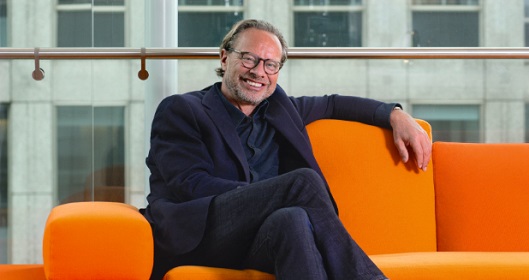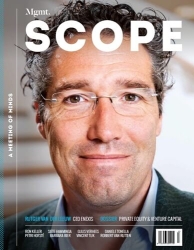'After the sale, a long-term relationship begins'

21-03-2019 | Interviewer: Stef Oud | Auteur: Paul Groothengel | Beeld: Maartje Geels
It is now three years since Philips split off the lighting division and combined the personal health and health systems divisions into the new Philips. In taking this step, the technology company brought a sharp focus and it is more than ever active throughout the care chain, with products and services that cover the entire care spectrum: from a healthy lifestyle and prevention to diagnostics, treatment, recovery and where necessary home care. Since then, this strategic choice has been of great benefit to Philips. Sales of diagnostic equipment − primarily MRI and CT scanners, but also personal care products such as shavers and electric toothbrushes − continue to grow steadily.
The world in which Philips operates is changing rapidly. Care is increasingly being digitalized, focused on measurable outcomes and, as far as possible, delivered to the individual patient. The days when scientists were working alone in development laboratories are long gone. Sector partners − not only hospitals, manufacturers and health insurers, but also scientists and doctors, as well as patients and their representatives − are increasingly working together to create new sustainable care models. They are exploring useful applications of digital technologies to encourage self-care, process improvement and cost control. Medical innovation centres are now close to the ‘customer’ (or patient), are digital and make use of multi-disciplinary expertise and creativity.
Philips is strongly committed to facilitating co-creation processes, enabling advanced technologies, clinical and technical expertise to merge into new business models. Sometimes the outcome is clear and practical: for example, Philips developed a special diabetes app together with Radboud UMC. This app enables patients to monitor blood sugar levels, insulin consumption, nutrition, physical activity, mood and stress, among other things. They can then receive feedback and coaching advice at home or on the go. This app is one of the many examples of connected care. The acquisition of the Dutch software companies VitalHealth and Forcare strengthens this approach. Real innovation lies in all kinds of − often long-term − partnerships. This applies not only to Philips, but to the entire sector. Philips is exchanging the sale of devices for far-reaching alliances with hospitals and care institutions, among others. The Eindhoven-based healthcare group advises and supports hospital administrators and healthcare professionals in the field of medical technology and IT solutions, but also helps to improve business processes that increase the quality and efficiency of healthcare.
All this falls under the final responsibility of chief innovation & strategy officer Jeroen Tas. In 2011, after an impressive career, Tas returned to the old nest, where he started as a consultant 35 years ago.
You have strategy and innovation in your portfolio. How does Philips shape both in the current context of accelerating digital transformation?
‘We were used to developing annual plans, and a three-year plan for the long term. This is important, but it is not sufficient to clearly define the direction. The risk is that plans become too linear. As far as our strategy is concerned, we need to look further and more broadly and make hypotheses about market developments, about the wishes and demands of consumers, about how payment methods will change, et cetera. For example, there is the hypothesis that people are becoming increasingly interested in their health, which means that information about this is becoming increasingly valuable to them. It is impossible to predict exactly how and when this will happen, but it will happen. The same is true of the arrival of the fast mobile network 5G. This technology will enable us to offer new, highly relevant propositions to the consumer. When 5G will break through on a large scale is impossible to say, but that it will arrive is certain. Based on these kinds of hypotheses, we determine our strategic vision and direction, but not the exact path towards it.’
Do you approach innovation differently from before?
‘Innovation is and remains the core of our success, but our approach has indeed changed. We used to develop technology for which we then tried to find applications. At this juncture, technology is a decisive factor for us when it comes to new propositions and especially for new business models. Whereas we used to deal with standalone products, we are now looking − sometimes via platforms − for connected models and broader solutions that enable healthcare providers to make the right decision at the right time. This not only gives you the best outcome for the patient, but also a better operational and financial performance for the hospital.’
Could you give an example of this?
‘For example, we offer technology with which you can remotely monitor patients in an intensive care department (IC). Currently, one in eight IC beds in the United States are monitored remotely, using our technology. Suppose a hospital has 50 IC beds with 50 monitors displaying all kinds of data of that patient. A few nurses are constantly walking there to keep an eye on all these patients 24/7. But sometimes they see something too late, or miss something. If you let an intensivist watch from a distance, he can quickly assist nurses. You can easily scale up this solution. This results in better outcomes for the patient and lower costs. We are doing this in India, among other places. Well-trained intensivists from Delhi don't always want to live in a small town and work there for the local hospital. Using our technology, they watch the IC departments of a series of smaller hospitals from Delhi. That is an asset for all parties.’
Simple care is increasingly disappearing from hospitals; people want to receive care at home where possible. Does Philips also develop business models for that?
‘Yes, that's a huge growth market. People do indeed prefer to be cared for at home. In addition, we are familiar with the situation where, when you are discharged from hospital, you suddenly return home without any care. Some patients find this quite scary, this abrupt transition. That is why we are working on the hospital@home concept. With the Arnhem Rijnstate Hospital, we have launched an initiative to treat patients partly remotely at home and no longer within the hospital walls.’
Sometimes you work closely with a competitor, such as Medtronic, with which you run a platform for lung cancer patients.
‘There is no longer a single care path in which only one supplier is involved. That is why we do indeed participate in various alliances, sometimes as an orchestrator, sometimes as a participant. Is this difficult? No. You have to constantly determine for yourself your position and strength in this kind of alliance. The medical world has become too complex to simply compete with direct competitors in terms of prices, for example. Sometimes it is more sensible to work together, which ensures better outcomes for both the patient and the hospital or care institution. In addition, you can still create enough room for yourself to continue to innovate and create your own unique proposition.’
A long time ago Philips made beautiful products for which it then tried to find a target group, sometimes in vain. How do you prevent this product focus in current innovation processes?
‘We don’t invest in anything unless there is clear co-creation with the customer and a clear value model. Nor do we make any investment if we don’t know how a customer can fit our idea into his business operations, or if it is not clear how that customer can finance our technology concepts. It could not be otherwise, because we no longer live in a transactional world, but in a world where everything revolves around long-term relationships. We used to sell an intervention lab, and that was it − on to the next customer. Now we are selling this kind of laboratory to a hospital, after which a long-term relationship begins. Take Azurion, our platform for image-guided interventions. After the sale, we assist a hospital in the operational running of this kind of lab, for example, by showing those involved how they can ensure that they can perform seven instead of the usual five procedures a day. The patient is helped more quickly and as a hospital you improve your financial results, because you treat more people in the same space of time. Moreover, together with the hospital, we analyse all the data that such a lab provides in order to see where we can further improve procedures.’
Philips also knows better what hospitals want, because you bring medical practitioners to Philips, such as paediatrician and former hospital manager Jan Kimpen, your chief medical officer.
‘Jan plays a major role with us. He has headed the University Medical Center Utrecht and a medical centre. He understands both the scientific side and the medical care side. I am just a technician, without people like Jan, I am nothing, haha. Jan is not the only one: our chief medical officer for our image-guided intervention business has his own lab and still performs operations himself every Friday. My head of research in the US is an absolute specialist in acute care: he is working among IC patients in an intensive care department one or two days a week. We are and continue to be a medical technology company, but we are increasingly intertwined with other parties in the medical world.’
How does Philips organize digital activities? Is there a separate department or are these activities embedded in the organization?
‘Mainly the latter. Digital skills are essential to our future, which means that we are working on digital solutions in all our existing businesses. Our data scientists work with the business in multidisciplinary teams − not only on complex, smart monitors, but also on electric toothbrushes. We sell connected toothbrushes, giving consumers an insight into their brushing behaviour through an app and direct feedback from professionals. In this way we try to improve the bond between consumer and dentist. We also have apps for mothers who have just had a baby. Between three and four million mothers use them every day. This app is not yet profitable, but offers us a huge number of opportunities to offer the right propositions. Using artificial intelligence, we analyse a person’s search behaviour on that app: in principle, we can develop products that meet real needs much more quickly.’
People get older and pay more attention to their health. There are plenty of opportunities for Philips, but are there any risks?
‘Of course. We can come up with all kinds of great solutions and concepts, but this question always remains: does the customer really want this and what is the speed of adoption? Another risk is the extent to which we get our own organization involved in this transformation. Are our employees able to make the big leaps we have in mind? Related to that: we can also go too far. It is not only risky if we run too far ahead of the music, but also dangerous if we forget our core business as a result. Because with the income from our core business we do pay our bills. On the one hand, we are fully committed to innovation, on the other hand we must optimise our existing business. That is a delicate balancing act.’
Interview: Stef Oud


